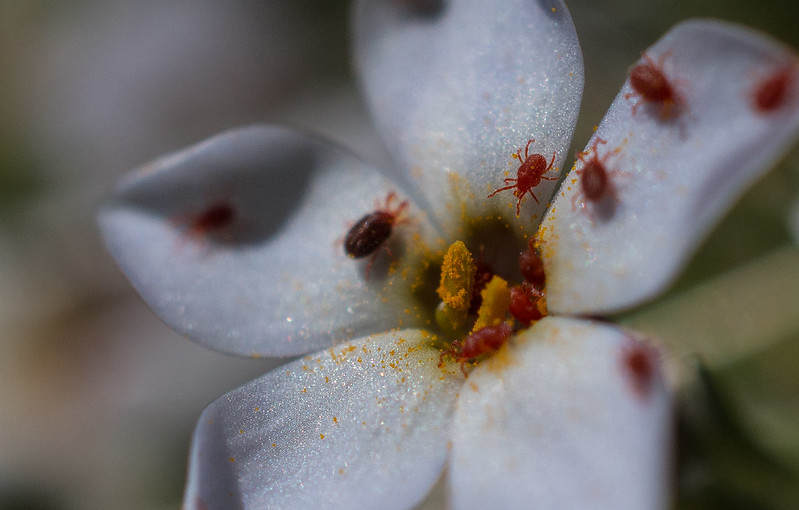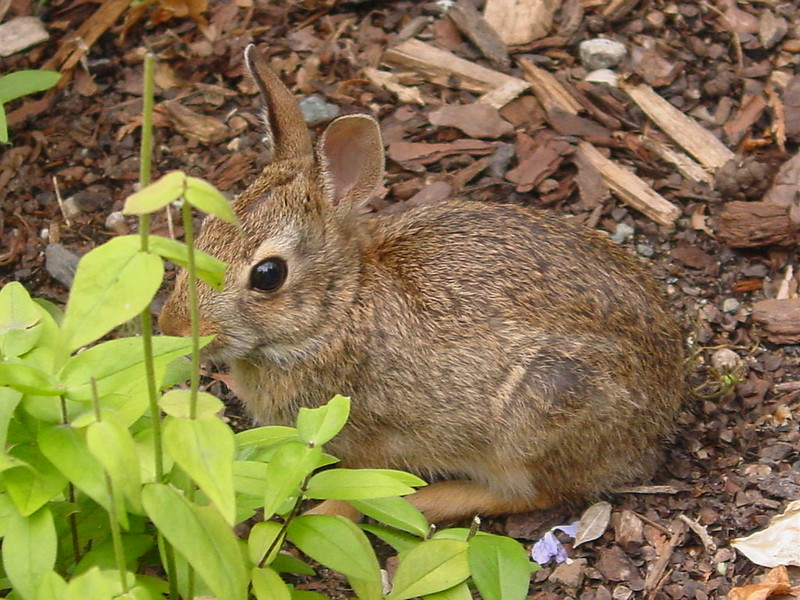Phlox yields bunches of delicate, vibrant flowers in varying shades of blue, pink, purple, and white throughout the summer. Encouraging phlox’s good health ensures this ornamental will bloom repeatedly. One aspect of maintaining this perennial’s health is pest control. Deterring pests such as mites, thrips, leafhoppers, aphids, deer, rabbits, and voles or properly controlling them as soon as they appear is critical to keeping your phlox growing strong.
Common Phlox Pests
Mites
Webs. When you spot webs clinging to phlox’s beautiful foliage, be wary of spider mites. These are tiny black, brown, red, or yellow arachnids that suck essential plant fluids from the undersides of phlox’s leaves. They leave small white spots on the leaves, which may eventually turn yellow or brown, fall off, and die.
Spider mites target stressed plants, so keep phlox as healthy as possible by properly watering, feeding, and pruning it. Also, take heed if you live in a warm, arid climate; spider mites tend to thrive in this environment.

Photo courtesy of Becky O'Neill
Treating Mites on Phlox
After identifying spider mites, trim affected leaves and discard them. Then, remove any remaining spider mites by wiping the foliage with a damp cloth or spraying the leaves with water. If the infestation is severe, treat with insecticidal soap or horticultural oil, such as neem oil.
Preventing Mites on Phlox
Since spider mites target stressed plants, make sure to adequately feed, prune, and water your phlox plants. Water during the early morning hours and focus on ground watering to minimize splashing of the foliage, which can promote fungal disease. Regularly remove weeds and dead plant materials to reduce hiding places for pests.
Also, diversify your garden to attract beneficial insects such as predatory mites, minute pirate bugs, and lacewings. Excellent companion plants that attract these insects include cosmos, dill, fennel, marigold, and mint.
Phlox Plant Bug
Phlox plant bugs or Lopidea davisi are sap-sucking pests that feed on the leaves and stems of phlox. Damage from this bug causes the leaves to brown, curl, and eventually drop. The small orange juveniles (nymphs) and larger black and orange adults can be observed on the leaves. The phlox plant bug has two generations: one in the spring and another in the summer.

Image courtesy of Missouri Botanical Garden
Treating Phlox Plant Bug
Spray the nymphs with an insecticidal soap or neem oil before they mature into adults. Avoid using chemicals when phlox is flowering to prevent damage to beneficial pollinators.
Preventing Phlox Plant Bug
The adults lay eggs in the stems, and the eggs overwinter and hatch in the spring. Prevent the bug from overwintering by cutting back the dead foliage in autumn and disposing of it in the trash.

Image courtesy of Missouri Botanical Garden
Thrips
Thrips are narrow, winged insects that remove essential fluids from phlox’s foliage and flowers. Evidence of the damage they cause includes yellowed or silvery-looking streaks on the leaves or flower petals. If left untreated, thrips can lead to stunted growth and the loss of foliage and flowers.
Treating Thrips on Phlox
You can treat a thrip infestation by pruning and discarding phlox’s damaged foliage and flowers. Then, spray the plant with a forceful stream of water. Finally, treat with insecticidal soap or plant oil such as neem oil.
Preventing Thrips on Phlox
Since pests typically target stressed plants, keep phlox in good health to prevent an onslaught from thrips. This means watering it in the morning, weeding around it, and removing dead foliage and flowers after they have fallen to the ground. Proper feeding and pruning are essential as well. Applying too much fertilizer can weaken phlox and make it a target of thrips.
You can also lay pieces of aluminum foil around phlox to deter these pests, or plant companion plants to attract beneficial insects. Aluminum foil reflects sunlight that confuses the thrips and inhibits their ability to land on the plant. Beneficial insects, including minute pirate bugs, lady beetles, parasitic wasps, spiders, and mantises, eat thrips, so add plants to attract these insects, such as dill, fennel, lemon balm, marigold, mint, parsley, thyme, and yarrow.
Leafhoppers
Leafhoppers are winged insects that suck juices from phlox’s foliage. Damage caused by these pests appears as light-colored spots on the leaves known as stippling, along with yellowing, dropping, and dying leaves and stunted growth. Leafhoppers also spread diseases from plant to plant.
Treating Leafhoppers on Phlox
First, prune damaged foliage and discard it. Then, spray the foliage with water. Finally, treat with insecticidal soap or horticultural oil.
Preventing Leafhoppers on Phlox
Adequately water, fertilize and prune phlox to prevent this perennial from becoming stressed. Stressed plants are often targeted by pests such as leafhoppers. Water during the morning hours and weed the area around phlox.
Plant companion plants that attract beneficial insects such as damsel bugs, lady beetles, lacewing, minute pirate bugs, parasitic wasps, and spiders. Companion plants that attract these insects are fennel, lemon balm, parsley, marigold, dill, mint, parsley, thyme, and yarrow.
Aphids
Aphids are small, soft-bodied, winged or nonwinged insects that suck essential plant fluids from phlox’s tissue. They are likely to be found on phlox’s leaves, stems, and flower buds. Large infestations can lead to yellow, brown, or wilted foliage and stunted growth. Aphids also produce a sugary substance referred to as honeydew that can support the growth of sooty mold.
Treating Aphids on Phlox
Remove aphids by spraying them with water. Treat a severe infestation with insecticidal soap or plant oil.
Preventing Aphids on Phlox
Like other insects, aphids target plants in poor health. Maintaining phlox’s good health is key to preventing an aphid infestation. Properly fertilizing, watering in the mornings, and pruning phlox is your best method of prevention. Weeding and removing dead flowers and leaves are also essential. Doing these tasks eliminates places for aphids to hide and lay eggs.
Also, add companion plants such as cosmos, dill, fennel, goldenrod, yarrow, and zinnias to attract beneficial insects, including lady beetles, lacewings, soldier beetles, and parasitic wasps.
Deer, Rabbits, and Voles
While starved deer are more likely to eat plants they normally wouldn’t, they typically avoid phlox. In contrast to deer, however, rabbits and voles do enjoy munching phlox’s delicate florets. If rabbits and voles are eating only the blossoms, phlox will likely recover.

Photo by Holly, unedited, Flickr, Copyright CC by 2.0
Treating Damage from Deer, Rabbits, and Voles
If deer, rabbits, or voles eat only phlox’s flowers, this natural “deadheading” is not likely to harm this perennial. However, if these animals eat more than the flowers, phlox may not grow back, depending on the severity of the damage. Put a cage around the damaged plant and nurse it back to health until it is big enough to protect itself.
Preventing Deer, Rabbits, and Voles on Phlox
Building a six-foot fence is the most effective means of preventing hungry deer from eating phlox. However, this option may not be affordable or reasonable. If not, you can use other methods to repel the deer. Examples are placing nylon bags filled with human hair or sweaty shirts near phlox.
For rabbits and voles, fox urine is a superb choice to use as a repellent. Spray the urine near phlox and reapply each week and after rain.
Phlox Pests Chart
|
Pest |
Identifying |
Treating |
|
Mites |
Tiny black, brown, red, or yellow arachnids |
Trim affected leaves and discard them |
|
Phlox Plant Bug |
Green or yellow-green in color and have transparent wings with distinctive black markings |
Spray the nymphs with an insecticidal soap or neem oil before they mature into adults |
|
Thrips |
Narrow, winged insects, causes yellowed or silvery-looking streaks on the leaves or flower petals |
Prune and discard damaged foliage and flowers |
|
Leafhoppers |
Small, wedge-shaped insects, narrow bodies and large eyes |
Prune and discard damaged foliage and flowers |
|
Aphids |
Small, soft-bodied, winged or nonwinged insects |
Remove by spraying with water |
|
Deer, Rabbits, and Voles |
Rabits and voles eat phlox’s delicate florets |
Put a cage around the damaged plant and nurse it back to health |
Sources:
"Pest Damage on Phlox." Backyard Farmer. byf.unl.edu
"Phlox (Phlox)." Connecticut State - The Connecticut Agricultural Experiment Station. portal.ct.gov
 |
Author Suellen Barnes - Published 6-07-2023 |
